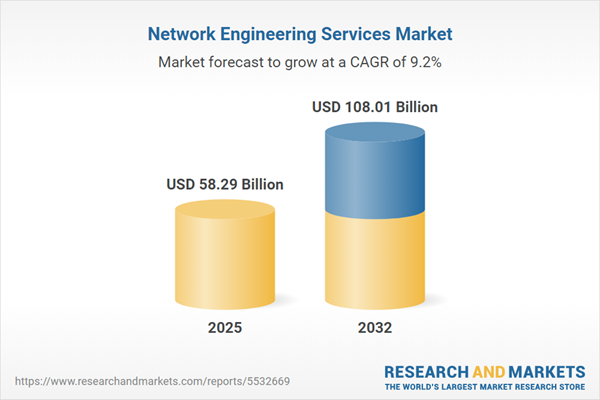Speak directly to the analyst to clarify any post sales queries you may have.
Network engineering services enable organizations to advance digital transformation with scalable, secure, and compliant networking solutions that support evolving business models. Senior decision-makers leverage these services to ensure reliable infrastructure, enhance security protocols, and drive operational efficiency in competitive markets.
Market Snapshot: Network Engineering Services Market Growth
Spurred by global digitalization, the network engineering services market continues to grow as enterprises and public agencies accelerate modernization efforts. Heightened emphasis on infrastructure that supports organizational agility and business continuity is shaping customer requirements. Key providers design services around robust security and seamless connectivity, integrating software-defined networking and cloud-first strategies. Adoption of industry partnerships and managed service models is evolving traditional network management, allowing businesses to respond effectively to operational challenges while maintaining flexibility across developed and emerging regions.
Scope & Segmentation of the Network Engineering Services Market
This report presents actionable insights for executives responsible for network strategy and procurement. The market is analyzed by essential segments, enabling alignment with sector-specific goals, compliance needs, and technical maturity across global markets.
- Service Type: Consulting, network design, implementation, maintenance, support, and managed services—each critical for building and operating robust enterprise networks, supporting up-time and scalability.
- End User Industry: Banking, insurance, government, defense, healthcare, information technology, telecom, and manufacturing—addressing varying industry regulations, compliance expectations, and specialized security protocols.
- Organization Size: Solutions tailored for both large enterprises and small to midsize businesses, ensuring compatibility with diverse workflows and business objectives.
- Technology: Cloud networking, Internet of Things (IoT), SD-WAN, local and wide area networking, and advanced wireless systems—delivering secure, agile connectivity fit for distributed and hybrid workforces.
- Deployment Type: Cloud-based and on-premises configurations—offering flexibility for data control, scalable growth, and risk management to suit operational requirements.
- Region: Americas, Europe, Middle East and Africa, and Asia-Pacific—enabling adaptation to local regulations and unique technical infrastructure across global markets.
- Key Companies: Cisco, Huawei, Nokia, Juniper Networks, Ericsson, Ciena, Arista Networks, Hewlett Packard Enterprise, Dell Technologies, and Fujitsu—driving market leadership and network protocol standards.
Network Engineering Services Market: Key Takeaways for Senior Leaders
- Software-defined and agile network solutions allow enterprises to dynamically adjust IT resources in response to changing operational and strategic priorities.
- Integrated cybersecurity meshes with compliance frameworks, supporting business resilience in highly regulated sectors and promoting robust risk controls.
- Managed service adoption reduces downtime and ensures high network availability, even in complex, multi-site operational environments.
- Industry-specific solutions help regulated industries balance advanced protection with process efficiencies unique to healthcare, financial services, and government.
- Deployment of edge computing and cloud-native technologies enhances infrastructure continuity and enables businesses to operate seamlessly across multiple locations.
- Standardized deployment approaches improve security and streamline integration, supporting reliability goals for organizations of all sizes.
Tariff Impact: United States Tariffs Introduced in 2025
The 2025 introduction of United States tariffs on networking equipment led enterprises to adjust procurement strategies by selecting more domestic suppliers and strengthening supply chain resilience. These changes increased sourcing diversity, reduced exposure to market volatility, and supported greater operational reliability for stakeholders.
Methodology & Data Sources
This analysis applies a robust mixed-methods approach, combining insights from executive interviews, regulatory assessments, and independent market research. The methodology informs practical, data-driven guidance for digital infrastructure planning and efficient procurement.
Why This Report Matters
- Helps executives align network investments with shifting regulatory and operational demands, supporting improved long-term strategic value.
- Strengthens business continuity by informing risk, compliance decisions, and procurement models in complex and regulated industries.
- Provides procurement leaders with perspectives on supplier evaluation, partnership models, and emerging technology alignment.
Conclusion
Enterprises investing in adaptable networks, resilient supplier partnerships, and advanced security are well-positioned to sustain digital transformation as operational needs and regulatory landscapes shift.
Additional Product Information:
- Purchase of this report includes 1 year online access with quarterly updates.
- This report can be updated on request. Please contact our Customer Experience team using the Ask a Question widget on our website.
Table of Contents
3. Executive Summary
4. Market Overview
7. Cumulative Impact of Artificial Intelligence 2025
Companies Mentioned
The companies profiled in this Network Engineering Services market report include:- Cisco Systems, Inc.
- Huawei Technologies Co., Ltd.
- Nokia Corporation
- Telefonaktiebolaget LM Ericsson
- Juniper Networks, Inc.
- Ciena Corporation
- Arista Networks, Inc.
- Hewlett Packard Enterprise Company
- Dell Technologies Inc.
- Fujitsu Limited
Table Information
| Report Attribute | Details |
|---|---|
| No. of Pages | 189 |
| Published | November 2025 |
| Forecast Period | 2025 - 2032 |
| Estimated Market Value ( USD | $ 58.29 Billion |
| Forecasted Market Value ( USD | $ 108.01 Billion |
| Compound Annual Growth Rate | 9.1% |
| Regions Covered | Global |
| No. of Companies Mentioned | 11 |









